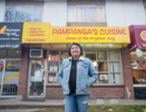Less than a week after the pews and floors at First United Church became a night time-shelter, the church’s Rev. Ric Matthews believes the experiment is already offering Vancouver’s newly minted homeless task force some “important lessons”.
“We need shelters to feel more homely,” said Matthews on Thursday night, just a few hours before a 47-year-old homeless woman named Tracey burned to death on the streets of the West End after earlier refusing to go into a shelter. “A shelter may not be a home, but it needs to feel like one.”
Unlike most shelters, First United doesn’t have any restrictions on its guests—people can come and go as they please, men and woman can stay together and people can bring their pets and shopping carts. Morning head counts found 175 slept in the church on Monday night, 162 on Tuesday night and another 180 on Wednesday night. Matthews said some homeless people like the First United shelter because it’s like a “sleepover with their friends”.
“I don't think shelters give people a sense of belonging,” said Matthews. “I think that’s something we need to explore.”
On his first day in office, Mayor Gregor Robertson announced the city, the province, St. Andrew’s Wesley Church and the Streetohome Foundation were giving First United roughly $40,000 to open it’s doors at night for 150 people. Located at the corner of East Hastings and Gore in the Downtown Eastside, First United has long been a daytime shelter from Monday to Friday. The grant now allows the church to operate from 8 p.m. to 7 a.m. seven days a week for the next three months.
A week later, Robertson and Premier Gordon Campbell announced another $1.5 million would go towards 200 shelter beds in the city for three months. The shelter openings are part of Robertson’s pledge to end street homelessness by 2015 and came under the umbrella of the newly formed Homeless Emergency Action Team (HEAT), a 13-person volunteer task force on homelessness.
When I went to visit the First United on Thursday night, it was –5 degrees Celsius outside and there were roughly 75 people tightly huddled together in the church’s pews and on the floor. While some people were talking, the church was fairly quiet and people were respectful to each other.
“It’s better to sleep in here than on the street,” said Leonard Joseph, a 53-year-old native man who has been unemployed for the past year. “Here I can come and go as I like. It’s more relaxed here [than in other shelters].”
But not everyone is convinced that opening up the church as a shelter is a good idea. Long-time Downtown Eastside activist Jamie Lee Hamilton, who was touring the church when I was there, believes turning a church into a shelter is no solution.
“Warehousing our poor citizens in churches and providing them wooden pews or the floor to sleep is a further indignity and I just can't believe that not one politician or media outlet has had the guts to step forward and say this is wrong,” she wrote on her blog.
While Joseph said he had no problem sleeping on the floor (“I’ve been sleeping on a floor my whole life”), others admitted it was hard to fall asleep. Darrell Heavelrnor, a 55-year-old homeless native man, was pacing around because he was having difficulty getting comfortable on the ground. But he still felt the First United shelter was a “good thing”.
“Shelters aren’t the solution, you need housing,” said Heavelrnor. “But shelters are a part-time solution.”
While Matthews agreed that beds are preferable to pews, he said the large numbers coming to First United show that a bed is not the most important factor for a person seeking shelter. He argued that people seem to prefer a safe and friendly atmosphere where they feel comfortable.
But what Matthews doesn’t know yet is whether First United is actually bringing people off the street. Judy Graves, the coordinator of the city’s tenant assistance program, said since First United opened on Monday the streets of the Downtown Eastside have been empty at night. She said the best thing about the shelter is that it opens at 8 a.m., while most emergency weather shelters don’t open until midnight.
“People are desperate to get warm and get off the street and I think this documents really well that people are desperate to get inside,” said Graves.
However, the people I spoke to at First United all said they have been using other shelters for the past month and have not had to sleep outside. Walking around the neighbourhood at around 11 p.m., I found a few people sleeping on benches and in doorways. Some clearly had mental health issues, while others said they simply weren’t interested in going inside.
“It’s too packed in [First United],” said a homeless man sleeping in a doorway on Alexander Street who did not want to give his name. “And it smells.”
Tracey, apparently, also had issues about shelters since she reportedly refused efforts from St. Paul’s Anglican Church workers to go inside the night she died. While we’ll never know if she would have agreed to go into a place like First United, Matthews said it’s time for the city to start finding ways to make sure that people can find a shelter they feel is like home.
Sean Condon is the editor of Megaphone Magazine.










What have we missed? What do you think? We want to know. Comment below. Keep in mind:
Do:
Do not: